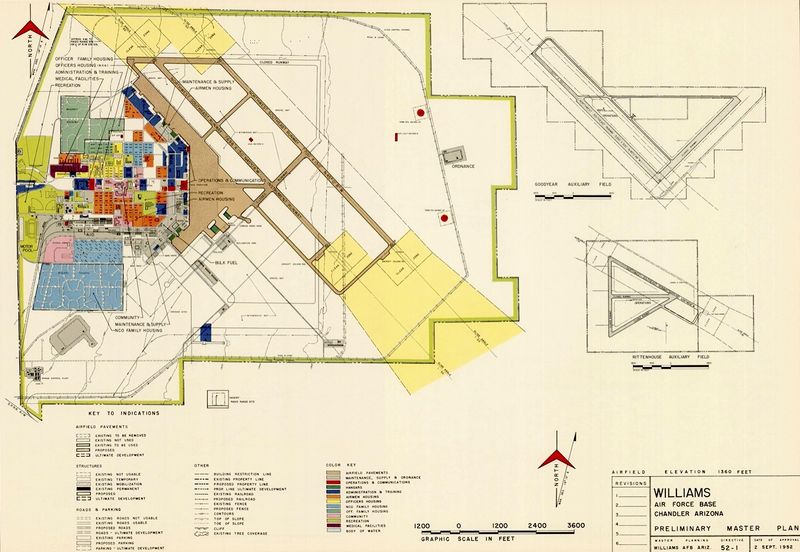Williams Air Force Base
|
Pre World War IIWilliams Field was located near Chandler, Arizona, approximately 30 miles southeast of central Phoenix, encompassing some 4,127 acres. At the time the base was built, it was surrounded by irrigated farmland and desert. The base was constructed in 1941 by the Del E. Webb Construction Company to serve as a training facility for primary pilot training. Today the successor civil airfield is located in Mesa, Arizona. Gearing up for the coming demands for World War II combat pilots, the Army Air Corps broke ground in southeast Mesa for its Advanced Flying School on 16 Jul 1941. World War IIWith the declaration of war in December 1941, the training tempo at Williams Field increased. Thousands of future P-38 Lightning pilots learned their twin-engine flying skills flying the Beech AT-10 Wichita at Williams Field. By July 1942, there were 79 AT-10s assigned to the field. Training with the AT-10 was scrapped when the aircraft was found unsuitable in the dry Arizona climate. They were then replaced by the Cessna AT-17 Bobcat twin-engine trainers. The AT-17 was then found "too easy to fly" and they were replaced by the Curtiss-Wright AT-9. By January 1943, almost 200 AT-9s were at the Williams Field. The training version of the P-38 (RP-322) began to arrive in early 1944, and by May, the flying school was involved in four courses of instruction. By far, the largest course was a single-engine advanced course where cadets received instruction on the AT-6 Texan and then advanced to the twin-engine AT-9, then on to the RP-322. Post World War IIFollowing the end of the war, most temporary WWII bases were closed but Williams Field remained open, and in 1945 began jet pilot training with the P-80 Shooting Star along with P-51 Mustang and P-47 Thunderbolt training. The single-engine basic pilot school (T-28 Trojan) was discontinued at Williams and replaced with an advanced fighter school with T-33s exclusively.  After the creation of the U.S.Air Force in 1947 Williams Field was redesignated as Williams Air Force Base (WAFB) in January 1948. WAFB was the foremost USAF pilot training facility, graduating more student pilots and instructors than any other base in the country and supplying 25 percent of the Air Force's pilots annually. The T-33s began to be phased out in 1962, replaced by the T-38 Talon as the primary jet training aircraft. T-38s were used until the closure of Williams in 1993 along with the Cessna T-37 "Tweet" Both trainers were two-seat, dual-engine jet aircraft, the T-38 being capable of supersonic flight. Williams AFB was selected in 1963 to support the Military Assistance Program (MAP) F-5A/B Freedom Fighter sales by providing pilots and maintenance training personnel. The F-5 was a lightweight fighter designed for allied nations and was not programmed for USAF use. ClosureThe host unit at Williams AFB, the 82d Flying Training Wing, was inactivated on 31 Mar 1993. This left 82d Operations Group to close Williams AFB and it was inactivated and the base was closed on 30 Sep 1993. Current StatusIn March 1994, the airport reopened for public use as Williams Gateway Airport. In 2008 the name was changed to Phoenix-Mesa Gateway Airport. The Air Force has spent more than $93.54 million on the cleanup and millions more will be spent for ongoing monitoring and operation of groundwater treatment and soil cleanup systems, and maintenance and monitoring of landfill sites. In 2011, the airport served nearly one million total passengers, with more than 171,200 takeoffs and landings, making it the 65th busiest airport in the United States.
See Also: Sources:
Fortification ID:
Visited: No
| ||||||||||||||||||||||